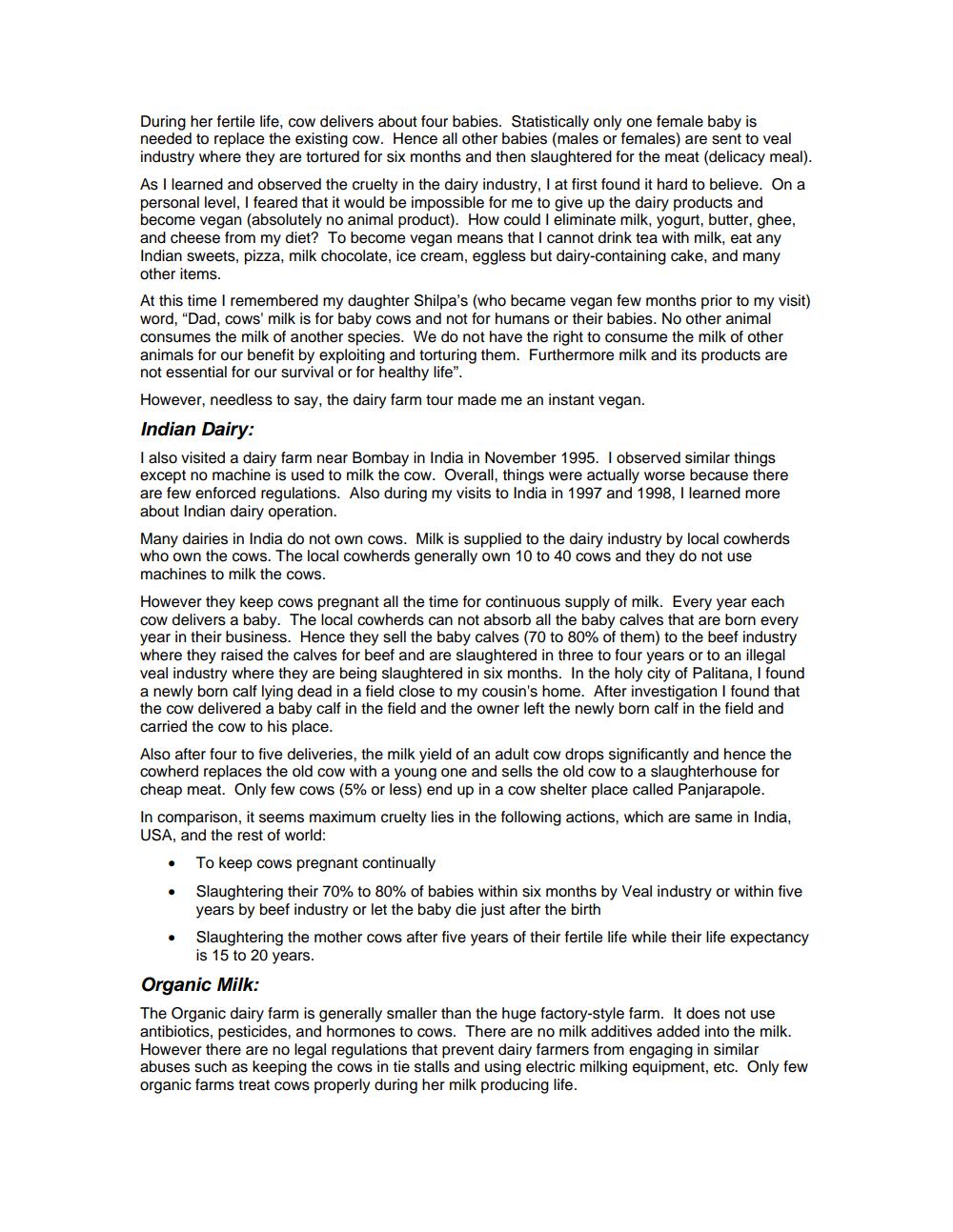Book Title: My Visit to a Dairy Farm Author(s): Pravin K Shah Publisher: JAINA Education Committee View full book textPage 2
________________ During her fertile life, cow delivers about four babies. Statistically only one female baby is needed to replace the existing cow. Hence all other babies (males or females) are sent to veal industry where they are tortured for six months and then slaughtered for the meat (delicacy meal). As I learned and observed the cruelty in the dairy industry, I at first found it hard to believe. On a personal level, I feared that it would be impossible for me to give up the dairy products and become vegan (absolutely no animal product). How could I eliminate milk, yogurt, butter, ghee, and cheese from my diet? To become vegan means that I cannot drink tea with milk, eat any Indian sweets, pizza, milk chocolate, ice cream, eggless but dairy-containing cake, and many other items. At this time I remembered my daughter Shilpa's (who became vegan few months prior to my visit) word, "Dad, cows' milk is for baby cows and not for humans or their babies. No other animal consumes the milk of another species. We do not have the right to consume the milk of other animals for our benefit by exploiting and torturing them. Furthermore milk and its products are not essential for our survival or for healthy life". However, needless to say, the dairy farm tour made me an instant vegan. Indian Dairy: I also visited a dairy farm near Bombay in India in November 1995. I observed similar things except no machine is used to milk the cow. Overall, things were actually worse because there are few enforced regulations. Also during my visits to India in 1997 and 1998, I learned more about Indian dairy operation. Many dairies in India do not own cows. Milk is supplied to the dairy industry by local cowherds who own the cows. The local cowherds generally own 10 to 40 cows and they do not use machines to milk the cows. However they keep cows pregnant all the time for continuous supply of milk. Every year each cow delivers a baby. The local cowherds can not absorb all the baby calves that are born every year in their business. Hence they sell the baby calves (70 to 80% of them) to the beef industry where they raised the calves for beef and are slaughtered in three to four years or to an illegal veal industry where they are being slaughtered in six months. In the holy city of Palitana, I found a newly born calf lying dead in a field close to my cousin's home. After investigation I found that the cow delivered a baby calf in the field and the owner left the newly born calf in the field and carried the cow to his place. Also after four to five deliveries, the milk yield of an adult cow drops significantly and hence the cowherd replaces the old cow with a young one and sells the old cow to a slaughterhouse for cheap meat. Only few cows (5% or less) end up in a cow shelter place called Panjarapole. In comparison, it seems maximum cruelty lies in the following actions, which are same in India, USA, and the rest of world: • To keep cows pregnant continually Slaughtering their 70% to 80% of babies within six months by Veal industry or within five years by beef industry or let the baby die just after the birth Slaughtering the mother cows after five years of their fertile life while their life expectancy is 15 to 20 years. Organic Milk: The Organic dairy farm is generally smaller than the huge factory-style farm. It does not use antibiotics, pesticides, and hormones to cows. There are no milk additives added into the milk. However there are no legal regulations that prevent dairy farmers from engaging in similar abuses such as keeping the cows in tie stalls and using electric milking equipment, etc. Only few organic farms treat cows properly during her milk producing life.Page Navigation
1 2 3 4
